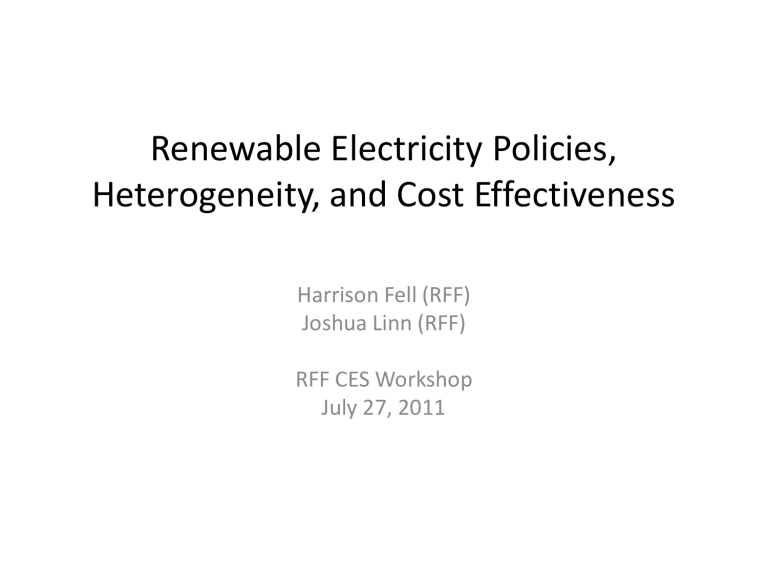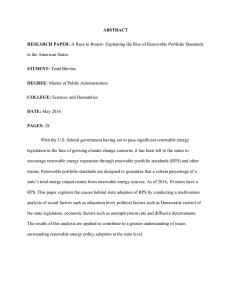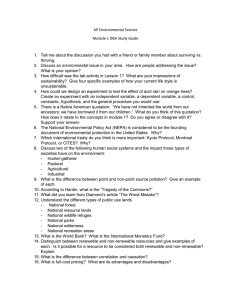Renewable Electricity Policies, Heterogeneity, and Cost Effectiveness Harrison Fell (RFF) Joshua Linn (RFF)

Renewable Electricity Policies,
Heterogeneity, and Cost Effectiveness
Harrison Fell (RFF)
Joshua Linn (RFF)
RFF CES Workshop
July 27, 2011
Background: heterogeneity
• Recent literature on wind and solar
– Intermittency: generate electricity when resource is available
– Market value depends on correlation with demand/price
(Lamont, 2008; Joskow, 2010, and Castillo and Linn, 2011)
– Environmental value depends on displaced emissions from marginal generator; varies over time and space (Cullen, 2011;
Kaffine et al ., 2011)
• What does heterogeneity mean for policy?
– Typically, renewable electricity policies provide the same implicit subsidy regardless of market or environmental value
– What is the cost of not fully internalizing these values?
2
Outline of paper and presentation
• Focus on:
– ERCOT (Texas) and PJM (Pennsylvania, New Jersey, Delaware and
Maryland)
– Wind (solar to come…)
• Document heterogeneity
– Use observed electricity prices to estimate market value
– Complements literature on environmental value
• Simple investment model
– Different policies cause different wind investments
– Characteristics of wind generators affects non-renewable investment, demonstrating importance of long run analysis
• Simulations using more detailed model
– Taking existing system as given, estimate investment needed to meet future demand growth
– Compare baseline with carbon price and RPS (other policies to come …)
Market and environmental value of wind generation
• Wind data
– Data from from NREL and ERCOT
– Hypothetical units selected based on resource availability
– Hourly simulated generation using atmospheric conditions,
2004-2006
• Market value
– Using 2006 price data, estimate average price each simulated wind generator would have received
– Estimate average cost of energy (LCOE) using 2010 cost assumptions and simulated capacity factor
4
Map of regions used for simulated wind generators (ERCOT)
5
Average Electricity Price vs. Levelized Cost of Energy
6
Example of Hourly Capacity Factor of Two Simulated Units
(ERCOT)
June 28, 2006
120
100
80
60
40
20
0
0
Price
5 10 15
Unit 236 (right axis)
0.5
0.4
0.3
0.2
0.1
0
20 25
Unit 401 (right axis)
0.9
0.8
0.7
0.6
7
Conclusions on heterogeneity
• Market value
– Even among high-wind locations, average cost varies
– Average revenue varies because of correlation with prices
– Cost and revenue are negatively correlated
• Environmental value varies across regions and generators
– Cullen (2011) and Castillo and Linn (2011): 0.72 tons CO2/MWh
(ERCOT)
– Kaffine et al . (2011): 0.27 tons CO2/MWh (CAISO); 0.52 tons
CO2/MWh (ERCOT); 1.10 tons CO2/MWh (MISO)
• Upshot: it matters which generators will be constructed under renewable policies
– This is different from new non-renewable generators, which much are more similar (within a technology)
8
• Model structure
Summary of simple model
– Two time periods, day/night (high/low demand)
– Coal is base load, natural gas is peaking
– Two types of wind: produces at night or during day
• Renewable investment affects mix of non-renewable investment
– Nighttime wind displaces coal, which reduces amount of coal used during day
– Distinction between short run and long run
• RPS creates different incentives from carbon price
– RPS mandates fraction of renewable electricity, effectively subsidizing each MWh of renewable and taxing each MWh of non-renewable
– Carbon price raises marginal cost in proportion to emission rate
– Carbon price raises electricity price more at night
– RPS effectively adds a flat subsidy to the market revenue, and favors wind that produces during the day
9
Long run planning model
• Compare renewable policies and electricity price in the long run
– Do types of renewable investments and mix of nonrenewable investments vary across policies?
– Compare investment, emissions, welfare of producers and consumers, across policies
• Investment stage
– Separately model ERCOT (PJM still to come)
– Starting in 2006, allow for investment in initial time period to meet demand growth over time
– Model each existing generator separately
– Investment in 7 technologies: coal (two types), natural gas
(two types), wind (two types), nuclear; homogeneous within type
10
Model structure (cont.)
• Electricity market clears each hour for next 25 years
• Assume linear demand curve with price elasticity of -0.20
• Generators dispatched based on marginal cost, accounting for planned maintenance/outages
• Account for heterogeneity across existing (2006) generators
• Two types of wind generators: high and low correlation with 2006 prices
11
Solution Method
• Maximize social welfare:
max
K t
T
1
t
T
1
t
1 h
H
1 t
1
I i exist
1
1
2
( P max, ht
FOM K it i
ht
) t
P Q ht ht
H h
1
c q it iht
I i new
1
FOM K it i
h
H
1
c q it iht
I i new
1
F K i i
• Subject to production constraints
• Because of non-linearities in short run supply curve, solve maximization via genetic algorithm
12
Scenarios
• Baseline
– Fuel price and capital cost assumptions from AEO 2010
– Observed heat rates for existing generators (EIA, EPA); operating and maintenance characteristics from Haiku
– Project 1 percent annual demand growth
• Production Tax Credit: $20/MWh
• Carbon price: $30/ton
• RPS: same amount of wind as carbon price
13
Overview of results
• Investment
– Mix of renewable generators varies by scenario
– Mix of non-renewable generators also varies
• Electricity prices, emissions, and producer/consumer welfare
– Electricity prices increase more with emissions price than with
RPS (roughly constant with PTC)
– Welfare costs to producers and consumers greater for RPS than emissions price, reflecting different investment mix
14
Table 1: Investments (MW)
Technology
Coal
IGCC
Base
0
0
Gas/Oil Comb
Cycle
Gas Comb
Turbine
Nuclear
Wind (low corr.)
Wind (high corr.)
13,351
0
0
0
0
PTC
0
0
10,613
0
0
2,770
2,529
P e
0
0
0
0
0
8,768
9,200
RPS
0
0
3,590
0
261
3,585
12,689
15
80
75
70
65
60
55
50
45
2005
Electricity prices by scenario
Production-Weighted Average Annual Price
2010 2015 year
2020 2025
Base
PTC
P e
RPS
2030
16
Welfare costs relative to baseline
Scenario w/ Capital Cost w/o Capital Cost
PTC
P e
RPS
27.39
31.77
33.89
67.05
24.21
49.43
17
Conclusions and future work
• Market and environmental value vary across wind generators
• Renewable electricity policies tend not to account for this
• Renewable policies and emissions price cause different mixes of renewable and non-renewable investment
– Compared to emissions price, RPS causes more investment in high-correlation wind
• Future work for this paper and beyond:
– Modeling enhancements, such as operating constraints
– Add solar, PJM
– Compare with clean energy standard and feed-in tariff
– Uncertainty and multiple investment stages
18









